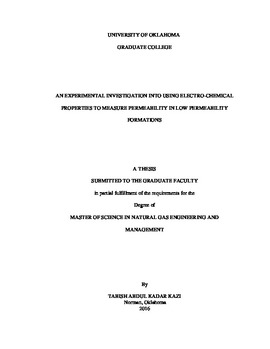| dc.description.abstract | Permeability is one of the most important property in the study of rock formations. Different permeability measurement techniques have been used in the industry, some of which are based on modelling while others on experiments. The most widely used techniques are mercury intrusion porosimetry, GRI (gas research institute) technique and pressure pulse decay. These techniques have achieved varying amounts of success depending on the kind of formation. The main factor which binds these techniques is the parameter of pressure without which permeability measurements cannot be done. All these methods require pressure dependent equipment, pressurized cylinders, and special core holders etc. which are highly expensive.
In this study, we seek answers to the possibility of substituting the pressure parameter with an electro-chemical parameter like conductivity using a simple, cost effective setup. The study is based on the principle of osmosis and diffusion and is carried out on Indiana limestone, Sister Berea sandstone, Grey Berea sandstone and shale with sample lengths in the range of 0.07-0.1 inches. The tests were conducted in 250 ml beakers and temperature compensated conductivity meters were used for conductivity measurement. Fluids incorporated in this study were, 10%wt. /wt. KCl solution and deionized water. Wax was used as a sealant to prevent flow of fluids around the circumference of the rock samples.
The plots of conductivity readings were generated and analyzed with respect to time. It was observed that for indiana limestone with permeability in the range of 2-5 mD, the chemical equilibrium between different salinity fluids was absent. In case of sister berea with the permeability of 70 mD and grey Berea with the permeability of 130 md, the
xi
smooth path towards chemical equilibrium was observed. In case of shale with permeability of 150 mD, the initial convergence due to diffusion and osmosis was quick which in the later stages of the experiment slowed down. It was also observed that the length of the rock samples has a huge effect on the time taken to reach chemical equilibrium. | en_US |
